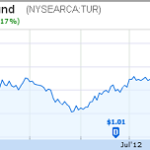When ETFSecurities launched its ETFS Physical Palladium Fund (PALL), it set the ETF scene on fire. Even regulators worried that the ETF may corner the market for physical palladium, one of the most rare of the industrial metals.
So far this year, Palladium has failed to keep pace with other well known metal funds. Here’s a chart comparing the performance of the ETFS Physical Palladium fund to gold, silver, and platinum funds:

The other funds in the chart above are:
- SPDR Gold Trust (GLD)
- iShares Silver Trust (SLV)
- ETFS Physical Platinum Shares (PPLT)
As you can see, every other metal available in ETF form is up year to date except for the lesser-known palladium.
What Makes Palladium Different?
Each of the four metals – gold, silver, platinum, and palladium – have completely different uses.
Gold remains a metal for fear; investors buy in heavy in anticipation of market meltdowns and increased inflationary concerns.
Silver, being an industrial metal, is driven by changes in manufacturing demand; the metal is driven most recently by changes in the solar industry, where silver is a necessary input to make photovoltaic solar panels.
Platinum is used in catalysis, with small amounts of platinum being used in the production of catalytic converters and industry, where it is used to kickstart chemical reactions. Due to its higher price, demand for platinum in jewelry is also increasing.
Palladium is 100% tied to automotive production. More common in catalytic converters than platinum, as much as 60% of palladium demand comes from the automotive industry. It’s not all that difficult to see the relationship between palladium and automakers when you examine the performance of palladium to automaker stocks:

Palladium tends to follow changes in automakers, and more importantly, to changes in automotive production.
Get Smarter Automotive Exposure
Knowing that palladium is a highly speculative metal tied to the automotive industry, it makes me wonder why anyone would hold it at all. To be fair, there are really two reasons why someone should own palladium:
- Investors expect increasing automotive sales, but not automotive profits. Now that American automakers (Ford and GM) have cleaned up their balance sheets and operations, this seems like an unlikely scenario.
- Investors expect increasing industrial inflation. Palladium does not have the same “store of wealth†value that gold and silver have. Increasing inflation in automotive production is unlikely without increased sales of new autos – bringing us back to point #1.
- Investors see future environmental law changes that would increase the use of palladium in catalytic converters. In the developed world, increased palladium consumption is unlikely. However, automobiles headed for the emerging markets could present the opportunity for future palladium consumption as environmental standards become more stringent.
- Investors believe fossil fuels will power personal transportation for some time. This seems to be the case; emerging markets will likely use fossil fuels well after developed economies turn to electric cars, if the switch happens at all.
Pick another Metal – or Car Stocks
ETFSecurities’ Palladium fund is nothing more than another ETF novelty, similar to water ETFs. The fund tracks a unique kind of non-metal exposure, with limited upside without fundamental change in its largest driver of demand: automotive manufacturing.
If investors want exposure to the anti-inflationary qualities of precious metals, gold, silver, and platinum would be a much better choice than palladium, although as I’d stated before and we’re seeing play out, there are many reasons NOT to own gold and other precious metals.
If investors want exposure to automotive manufacturing, why not buy into exposure directly? Three major automotive manufacturers (Toyota (TM), Honda (HMC), and Ford (F)) are positive carry, paying dividends to investors. Palladium held through the ETFSecurities ETF will cost investors .6% of their investment capital each year.
Disclosure: the author is currently long Ford Motor Company (F).











{ 0 comments… add one now }